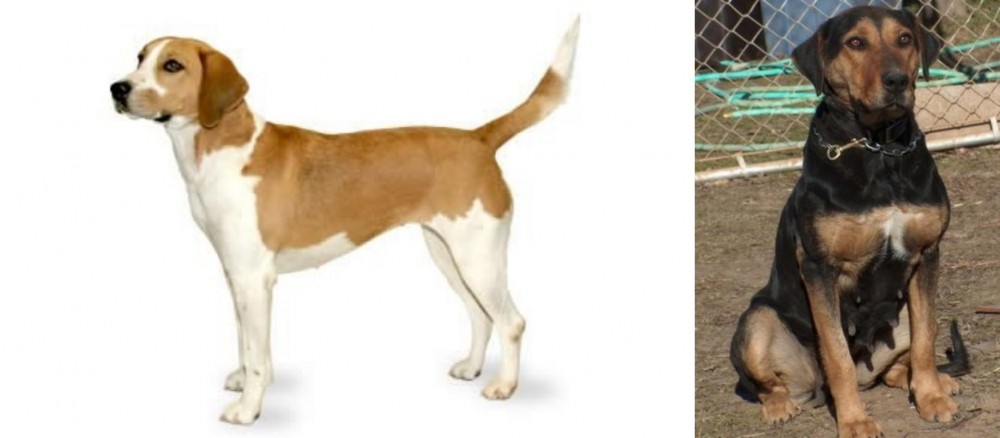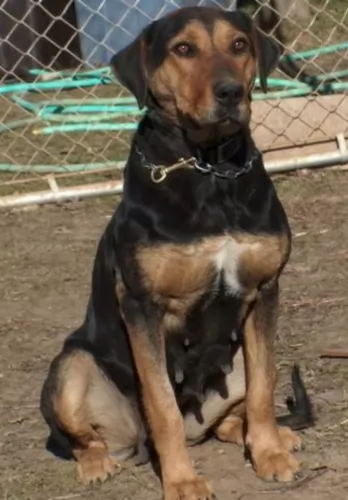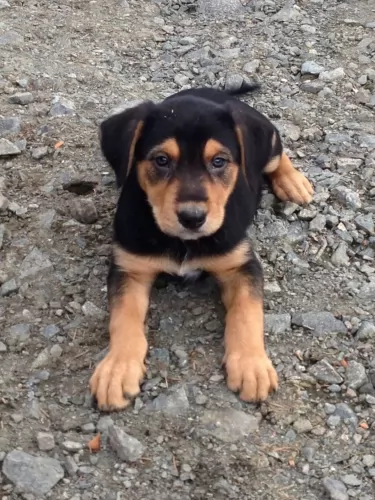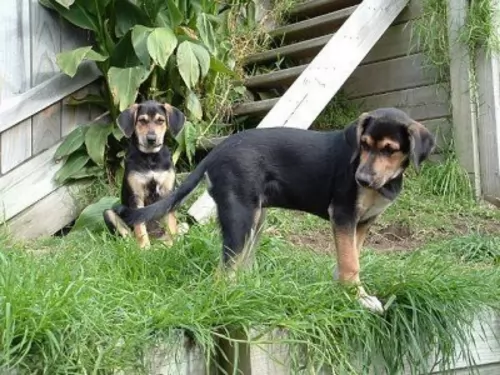 Petzlover
Petzlover Harrier is originated from United Kingdom but New Zealand Huntaway is originated from New Zealand. Harrier may grow 10 cm / 3 inches shorter than New Zealand Huntaway. Harrier may weigh 13 kg / 28 pounds lesser than New Zealand Huntaway. Both Harrier and New Zealand Huntaway has almost same life span. Harrier may have less litter size than New Zealand Huntaway. Both Harrier and New Zealand Huntaway requires Moderate Maintenance.
Harrier is originated from United Kingdom but New Zealand Huntaway is originated from New Zealand. Harrier may grow 10 cm / 3 inches shorter than New Zealand Huntaway. Harrier may weigh 13 kg / 28 pounds lesser than New Zealand Huntaway. Both Harrier and New Zealand Huntaway has almost same life span. Harrier may have less litter size than New Zealand Huntaway. Both Harrier and New Zealand Huntaway requires Moderate Maintenance.
 Developed in Great Britain, the Harrier is another hunting dog – a hound that primarily hunts hares and small prey. The breed itself is medium sized - smaller than an English Foxhound and larger than a Beagle. Although the definitive origins of the Harrier are not set, it is believed that he is a cross of the Basset Hound, Talbot Hound and Bloodhound. Others believe the breed is a cross of the Greyhound and the English Foxhound. The Harrier looks like a smaller version of the English Foxhound.
Developed in Great Britain, the Harrier is another hunting dog – a hound that primarily hunts hares and small prey. The breed itself is medium sized - smaller than an English Foxhound and larger than a Beagle. Although the definitive origins of the Harrier are not set, it is believed that he is a cross of the Basset Hound, Talbot Hound and Bloodhound. Others believe the breed is a cross of the Greyhound and the English Foxhound. The Harrier looks like a smaller version of the English Foxhound.
The Harrier is a pack dog and in 1260, Sir Elias de Midhope established the first pack in England. From there the breed spread to Wales and Western England, most used in Ireland where they hunt fox as well as hares. However, hunting hares is the specialty of the breed and even gave the breed its name. In 1885 they were recognized by the American Kennel Club in the Hound Group. Yet despite this and despite the number of Harriers working in England, they are not recognized by the UKC.
 The New Zealand Huntaway was developed in New Zealand. The dog was brought about by mixing the Border Collie with a number of other breeds, of which the Doberman Pinscher is one.
The New Zealand Huntaway was developed in New Zealand. The dog was brought about by mixing the Border Collie with a number of other breeds, of which the Doberman Pinscher is one.
The idea was to have a skilled herding dog for livestock, and the Huntaway is known for its loud bark which it uses to herd.
The dog is looked upon as as a fairly new breed, dating from the late 19th century. These days it is a popular companion dog, and in 2013 was recognized by the New Zealand Kennel Club.
 The Harrier is a typical hound dog much like the English Foxhound. The breed is a little smaller than the Foxhound but is muscular and large boned like his cousin. They have short hard hair that sheds and ears that hang. The Harrier is a large boned breed built for strength and stamina in the race with hares. They have broad skulls, strong muzzles, with hazel or brown eyes. They also have a black, wide nose and a high, medium length tail.
The Harrier is a typical hound dog much like the English Foxhound. The breed is a little smaller than the Foxhound but is muscular and large boned like his cousin. They have short hard hair that sheds and ears that hang. The Harrier is a large boned breed built for strength and stamina in the race with hares. They have broad skulls, strong muzzles, with hazel or brown eyes. They also have a black, wide nose and a high, medium length tail.
They say he has a ‘courtly grin’ on an expressive face. Being pack dogs, they must be sturdy, able to cover any type of terrain, for as long as the hare runs. It is critical that their scenting and running tools are exceptional. He is blue or yellow-pied. His feet are cat like and the chest is dropped low. He is an extremely well-proportioned dog
 As a deep chested, medium to large sized dog, the New Zealand Huntaway stands at between 50 and 60cm and weighs roughly 25 to 40kg.
As a deep chested, medium to large sized dog, the New Zealand Huntaway stands at between 50 and 60cm and weighs roughly 25 to 40kg.
The eyes are soft and kind. The coat is usually black and tan colored, although it can be brindle too. The coat is in different textures and can be mostly smooth, but also fairly rough textured. The ears are usually medium length and floppy, the legs straight and long and the tail is long.
These dogs are good natured and are guaranteed to make a splendid family pet. Because they have always been used to life in the country, they are more suited to this lifestyle than for living in the city.
They are friendly, energetic dogs and will require a good deal of exercise.They don’t take easily to lying around bored and this lifestyle will just lead to frustration and destructive behavior, through no fault of their own.
Just like with any other dog, the New Zealand Huntaway will need to be trained and socialized so that he becomes obedient and well rounded. This is necessary for him as he is an independent canine with a determined streak.
His intelligence will mean he is able to learn easily. He also is gentle and kind-hearted, and gets on well with kids and pets in the home.
 Yes, they are good with children but are very rambunctious and should be supervised with young children.
Yes, they are good with children but are very rambunctious and should be supervised with young children.
Scenting ability and wonderful personality
This breed is very adaptable as long as it gets enough exercise. He can live in the country or she can live in the city with an outlet for exercise.
Smart but stubborn at times. Therefore, his learning ability is moderate.
 The Huntaway has got so much going for him to make him a splendid family pet. Not only is he intelligent, but he is evenly balanced, friendly, social and active.
The Huntaway has got so much going for him to make him a splendid family pet. Not only is he intelligent, but he is evenly balanced, friendly, social and active.
He can easily be trained and socialized. He is friendly and gentle with other pets in the home as well as with children. With a firm, fair, kind, patient and consistent owner in his life, this dog with the gentle brown eyes will be a fantastic pet for you.
 It seems the only real health issue other than hunting accidents or foot and toe incidents due to hunting.is:
It seems the only real health issue other than hunting accidents or foot and toe incidents due to hunting.is:
This abnormality in the hip socket can cause arthritis and lameness that is very painful. This is the most severe form. The Harrier can have a milder form that does not progress to this level. Hip dysplasia has a genetic component, but the environment plays a role as well and active hunting dogs are especially prone to this.
Floppy ears that hang down are always susceptible to ear infections. Check them often and clean them at least weekly.
 The Huntaway is the kind of dog that won’t require you having to rush off to the vet with him. Good care with nutritious food and exercise can see him reaching 14 years of age or so.
The Huntaway is the kind of dog that won’t require you having to rush off to the vet with him. Good care with nutritious food and exercise can see him reaching 14 years of age or so.
Some common dog illnesses to look out for include -
This disease is about degeneration of the heart muscle with the muscle becoming thinner. The pressure of the blood inside the heart causes these thin walls to stretch, resulting in the heart becoming enlarged.
Although heart disease develops slowly, severe congestive heart failure can develop quickly and you may notice rapid breathing and a blue tongue. It is imperative to get your pet to the vet immediately.
Small studies have revealed that the rate of Dilated Caridomyopathy could be higher in Huntaways.
This is an issue where the hips haven’t formed properly. Affected dogs lose their mobility and battle with pain and lameness. Certainly you will need to get your pet to the vet to make sure that he is pain-free and comfortable.
 Feed a high nutrition puppy food dry food made for an energetic breed. Feed 3 times a day ½-3/4 cup each time.
Feed a high nutrition puppy food dry food made for an energetic breed. Feed 3 times a day ½-3/4 cup each time.
Again feed a high nutrition adult food for an active breed. Feed twice a day 1-11/2 cups each time.
Outstanding health unless in a hunting accident.
The Harrier is an energetic, hunting breed that needs a lot of exercise on a daily basis. Long walks and jogging or running is good for the Harrier. If they are not working, hunting dogs they need more exercise. A fenced yard for playing is good. If this intense breed does not get enough exercise and mental stimulation, he needs there could be issues with destructive behavior and obesity. Flyball, tracking, agility, coursing, rally and hunting are great activities for this breed of dog. In addition, they are pack animals and do better in a family that has more than one dog.
 This dog is an average shedder and fairly low maintenance, requiring you to brush him twice a week to keep the coat shiny and free from loose hairs.
This dog is an average shedder and fairly low maintenance, requiring you to brush him twice a week to keep the coat shiny and free from loose hairs.
Dogs that have floppy- or folded ears need to have their ears checked for infection as well as their eyes. They also need to have the nails trimmed as left long, they can hook onto things which can rip into the dog’s flesh.
The Huntaway is a herding dog, and even though your dog today is more of a companion dog, he will need to be fed a high-quality commercial dog food which has been particularly formulated for active working dog breeds.
It is a good idea to sometimes break away from a bowl of kibble and to mix in some homemade food. The simpler the better for your dog, and boiled chicken, some brown rice or pasta and some vegetables such as sweet potato, carrots and spinach mixed into his kibble occasionally will do him the world of good.
Now and then you can also add in some raw meat if possible. Avoid exotic, spicy foods with your pet to avoid digestive problems.
This dog has always been a hunting, herding dog so it is going to require a lot of exercise to keep him content and happy.
He won’t only need physical exercise but will also need mental stimulation as he is an intelligent dog too. Apart from taking him for walks and giving him ball- and rope games, for mental stimulation, why not consider some food puzzle toys?
These are sturdy containers that hold dog food and treats inside. Dogs have to paw at it, lick, shake and think up ways to get at the tasty treat. These food puzzle toys will keep your pet occupied for a while and keep him happily thinking.